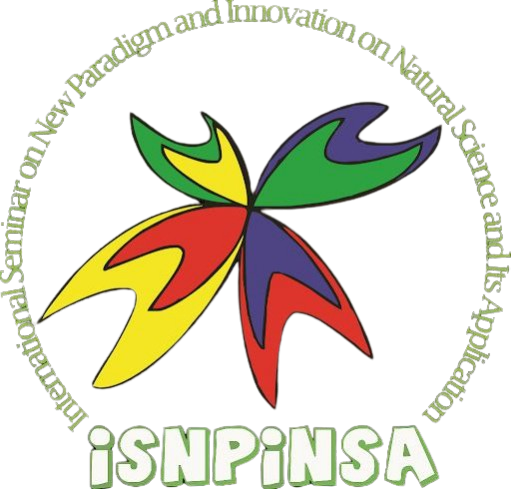The 14th ISNPINSA 2024 FSM UNDIP
International Seminar on New Paradigm and Innovation on Natural Sciences and its Application (ISNPINSA) is the annual conference organized by the Faculty of Sciences and Mathematics (FSM), Universitas Diponegoro (UNDIP), Semarang, Central Java, Indonesia. The Faculty of Sciences and Mathematics UNDIP is also a member of The Indonesian Network for Higher Education Institutions on Mathematics and Natural Sciences (MIPANET). A Network that consists of more than 50 Universities throughout Indonesia.
ISNPINSA has been successfully conducted since 2011 and has become an annual event since then. The objectives of ISNPINSA are to facilitate brainstorming and state-of-the-art information in the field of sciences and mathematics, to increase innovation of technology that can be applied in industries, to contribute to formulating a strategy to increase the role of science for the community, and to stimulate collaboration between industries, researchers, and government to increase community welfare. The theme of the 14th ISNPINSA in 2024 is “Contribution of Science and Technology for Sustainable Future”.
This annual ISNPINSA has intensively achieved high-level improvement in strengthening the collaboration between scientists from Indonesia (MIPANET members and various research Institutions) and other countries, stimulating a new research partnership, and contributing to formulating policies to increase the important roles of science for the community. The Seminar will only cover research and development in the following fields:
- Applied Physics, Computational Mathematics, Statistics and Informatics for Sustainable Future
Date and Venue
October 17, 2024
This conference was held virtually
Chairman
Dr. Moch. Abdul Mukid, S.Si., M.Si.
Keynote Speakers
|
No |
Name |
University/Institute/Organization |
|
1 |
Rezzy Eko Caraka, Ph.D |
Chaoyang University of Technology, Taiwan |
|
2 |
Prof. Tomoshige Miyaguchi |
Wakayama University, Japan |
|
3 |
Prof. Madya Dr. Radja Kamarulzaman |
Universiti Teknologi Malaysia, Malaysia |
|
4 |
Prof. Taufiq Asyhari |
Monash University, Indonesia |
Invited Speakers
|
No |
Name |
University/Institute/Organization |
|
1 |
Prof. Dr. Gassan Hodaifa |
Universidad Pablo de Olavide, Seville, Spain |
|
2 |
Rahmatia Fitri, S.Si., M.Si., Ph.D |
Pukyong National University, South Korea |
|
3 |
Drs. Pratama Jujur Wibowa, M.Si., Ph.D |
Universitas Diponegoro, Indonesia |
|
4 |
Dr. Nikken Prima Puspita, M.Sc. |
Universitas Diponegoro, Indonesia |
The conference featured four keynote speakers and four invited speakers from Spain, Japan, Taiwan, Malaysia, South Korea, and Indonesia. Organized as a one-day event, each keynote speaker delivered a presentation lasting approximately 30–40 minutes, followed by a 10–20-minute discussion with the audience.
The plenary session commenced with Dr. Rezky Eko Caraka from Chaoyang University of Technology, Taiwan, presenting an insightful talk on “Applying Data Science on Nighttime Satellite Imagery for SDGs Insights” (Figure 1). Next, Prof. Taufiq Asyhari from Monash University, Indonesia, explored technological discoveries that could contribute to a sustainable future, particularly in addressing climate change challenges (Figure 2).
Figure 1 Keynote Presentation from Rezky Eko Caraka, Ph.D.
Figure 2 Keynote Presentation from Prof. Taufiq Asyhari
Following these presentations, Prof. Madya Dr. Radja Kamarulzaman from Universiti Teknologi Malaysia, Malaysia, shared his expertise on “Challenges & Strategies in Elemental Identification of Organic Samples Using Laser-Induced Breakdown Spectroscopy (LIBS)” (Figure 3). The final keynote speaker, Prof. Tomoshige Miyaguchi from Wakayama University, Japan, delivered an engaging session on “Generalized Lavengin Dynamics in Elastic Network Models” (Figure 4). The keynote presentations were conducted via Zoom, allowing all conference participants to attend sequentially.
Figure 3 Keynote Presentation from Prof. Madya Dr. Radja Kamarulzaman
Figure 4 Keynote Presentation from Prof. Tomoshige Miyaguchi
After the keynote sessions, the invited speakers and oral presenters were divided into breakout rooms based on their respective topics. Each invited speaker delivered a 25–30-minute presentation, followed by a 10–15-minute discussion with attendees. These sessions were held in parallel breakout rooms, where participants subsequently presented their papers in 10–15-minute slots, concluding with five-minute discussions.
